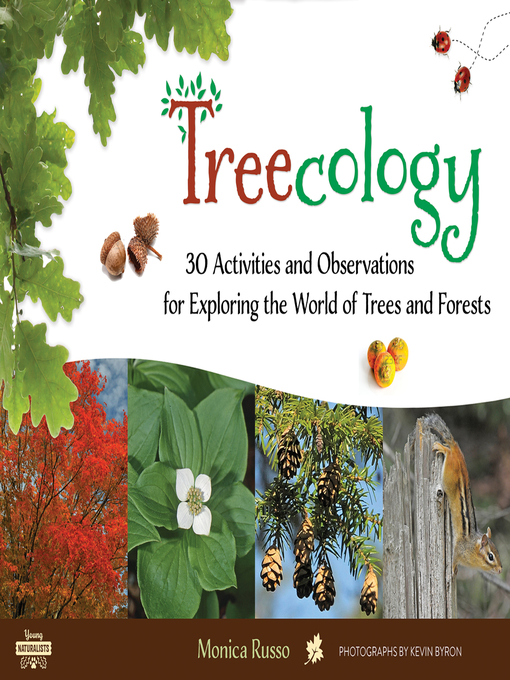Treecology
30 Activities and Observations for Exploring the World of Trees and Forests
2017 Outstanding Science Trade Books for Students K-12 (National Science Teachers Association - Children's Book Council)
Finalist for the 2017 AAAS / Subaru SB&F Excellence in Science Book exemplify outstanding and engaging science writing and illustration for young readers
Did you know . . .Trees have many talents—they can feed and house animals, create windbreaks, protect watersheds, and help prevent soil erosion. Researchers believe they have found the oldest tree in the world—a spruce in Sweden that has been alive for about 9,500 years. Even dead and decaying trees and stumps are often teeming with life!
Young nature enthusiasts will learn these and many other fascinating facts about the wonderful world of trees in Treecology. This fun and interactive resource includes plentiful full-color photos and drawings and clear, kid-friendly discussions of tree structures, families, and foods; the interaction between trees and the wildlife that depend on them; tree and forest–related jobs and preservation, and much more. With encouragement to "Try This," "Look For," and "Listen For," kids participate in 30 hands-on activities that promote observation and analysis, writing and drawing, math and science, and nature literacy skills. They will measure the circumference of a tree trunk, press and preserve leaves, study the textures of tree bark, find evidence of forest creatures, record their findings in a decorated forest logbook, and more. Readers from any region will start to take notice of the trees around them—not just in forests and woods but also around the schools, parks, buildings, and sidewalks of their town, and in their own backyards. Useful resources include a glossary of "tree terms," common and scientific names, a list of tree and nature organizations and groups, and a teacher's guide to initiate classroom discussion and investigation.
-
Creators
-
Series
-
Publisher
-
Awards
-
Release date
September 1, 2016 -
Formats
-
Kindle Book
-
OverDrive Read
- ISBN: 9781613733998
- File size: 13277 KB
-
EPUB ebook
- ISBN: 9781613733998
- File size: 13278 KB
-
-
Languages
- English
-
Levels
- Lexile® Measure: 980
- Text Difficulty: 5-7
-
Reviews
-
Publisher's Weekly
September 12, 2016
In this addition to the Young Naturalists series, Russo encourages readers to examine pockets of nature in their communities and the trees that grow there, whether in the yard, park, or forest. Accompanied by Byron’s photographs of trees and animals, the book’s 30 activities focus on observing, identifying, and learning about trees in the wild, several requiring only “sharp eyes” and a logbook to record observations. Sidebar panels succinctly explore different types of trees, the study of ecology, biodiversity, and other topics. It’s a comprehensive introduction to forests and trees that emphasizes appreciating the small changes and recurring patterns in nature. Ages 7–up. -
Kirkus
July 15, 2016
Enter the world of trees!This paperback invitation to the study of woodland ecology is nicely organized into chapters that lead from defining what a tree is and looking at individuals, through exploring wooded areas and the wildlife in and around the trees (and stumps!), and finally, to the relationships between trees and people and conservation issues. There's a generous helping of "look for," "listen for," and "try this" activities for exploring woodlands. Most examples reflect trees that can be found in the eastern and central parts of the United States and nearby Canada, but the narrative is not specific to any single part of North America. As in Birdology (2015), Russo doesn't talk down to her readers; this works for a wide age range. Activities range from simple observations to ongoing investigations. They require little equipment, sometimes only "your sharp eyes" and, later, a logbook. (She includes suggestions for making, decorating, and using one.) The 125 photos--of trees; leaves, bark, and other details; as well as plants, moss and lichen, and even insect and animal life--will be in full color. There are informational sidebars and drawings, too, as well as helpful backmatter. A labor of love reflecting years of experience in the field as well as in writing for young readers, this offers a path to interesting explorations of the natural world. (glossary, common and scientific names, resources, teacher's guide, bibliography, index) (Nonfiction. 8-15)COPYRIGHT(2016) Kirkus Reviews, ALL RIGHTS RESERVED.
-
School Library Journal
September 1, 2016
Gr 3-7-Readers with an interest in nature will find a plethora of information in this introduction to trees and woodlands. Amply illustrated with color photographs, the title explores topics including the ecological value of live and dead trees, the variety of animals and insects that depend on trees for sustenance and habitat, and the need for forest conservation. Thirty simple activities that emphasize observational skills are included. Sections of the text are adapted for readers who live in the city, with suggestions for exploring fauna in school yards and playgrounds. A chapter is dedicated to conservation, although the focus is limited to rare tree species and the jobs of conservationists, botanists, ecologists, etc. Mentions of global warming are minimal. Some passages are repetitious, and the dry tone may not produce much enthusiasm in readers. VERDICT Recommended for research projects involving trees and plant life.-Eva Elisabeth VonAncken, formerly at Trinity-Pawling School, Pawling, NY
Copyright 2016 School Library Journal, LLC Used with permission.
-
Formats
- Kindle Book
- OverDrive Read
- EPUB ebook
subjects
Languages
- English
Levels
- Lexile® Measure:980
- Text Difficulty:5-7
Loading
Why is availability limited?
×Availability can change throughout the month based on the library's budget. You can still place a hold on the title, and your hold will be automatically filled as soon as the title is available again.
The Kindle Book format for this title is not supported on:
×Read-along ebook
×The OverDrive Read format of this ebook has professional narration that plays while you read in your browser. Learn more here.



